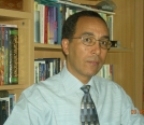Prof. Nidhal Guessoum is an Algerian astrophysicist who received his M.Sc. and Ph.D. degrees from the University of California at San Diego and spent two years as a researcher at NASA’s Goddard Space Flight Center. His research focuses on gamma radiation, mainly from the Milky Way Galaxy, but lately from other sources in the Universe as well; he has had an ongoing collaboration with colleagues at the Centre d’Etude Spatiale des Rayonnements in Toulouse, France. For the past decade or so, he has been at the American University of Sharjah (United Arab Emirates), where he chaired the Physics Department for a few years and presided over the Faculty Senate.
In addition to his technical papers, he has published dozens of articles on general science issues, edited a conference proceedings volume, and co-authored two general public books, The Determination of Lunar Crescent Months and the Islamic Calendar (two editions) and The Story of the Universe (three editions), both in Arabic. Lately, Prof. Guessoum has been active in the area of the Islam-Science interface. He has recently finished a book on Islam, modern science, and Western thought.
Professor Guessoum has been at the forefront of astrophysical research on the electron-positron annihilation process in the Galaxy, the emission coming mainly from the central regions. With the data from the INTEGRAL gamma-ray satellite, he and co-workers have helped improve our understanding of what has been a longstanding puzzle, namely the origin of the 10^43 positrons produced and annihilated each second. In parallel to this, Guessoum has pioneered the study of nuclear gamma-ray lines produced outside of the solar system, an emission which is undetectable at our present technological capacity but which could be within grasp of the next generation of instruments. Finally, he has lately ventured in the gamma-ray burst domain, which in the past decade or more has become one of the most stunning phenomena of the cosmos and has yet to be explained in a satisfactory manner.
Professor Guessoum has long had an interest in the questions at the interface between science and religion in general, and science and Islam in particular. His co-authored book on the “Story of the Universe” featured chapters on humanity’s old historical, cultural, and religious views of the cosmos, and he has often lectured on the historical and philosophical nature of the relation between science (in its ancient and modern versions) and Islam. In recent years, that interest has been molded into a serious endeavour; Guessoum was a member of Paris-based “Science and Religion in Islam” project; he took an active part in the 2008 conference on “Science, Cultures and the Future of Humanity”, which was held in Doha, Qatar; he has also published a number of articles and book reviews in the field. His most recent book is Islam’s Quantum Question:Reconciling Muslim Tradition and Modern Science (I.B.Tauris 2010).
Recent Science Publications
- “Positron Annihilation on PAHs in the ISM”, N. Guessoum, W. Gillard, and P. Jean, recently submitted.
- “Copernicus and Ibn al-Shatir: Does the Copernican Revolution Have Islamic Roots?”, N. Guessoum, The Observatory, 2008.
- “Microquasars as Sources of Positron Annihilation Radiation”, N. Guessoum, P. Jean, and N. Prantzos, Astronomy & Astrophysics, A&A, 457, 753 (2006).
- “First View of the All-Sky Distribution of Positronium Annihilation Continuum Emission with SPI/INTEGRAL”, G. Weidenspointner et al., Astronomy & Astrophysics, 450, 1013 (2006).
- “Ion acceleration and positron production and annihilation in solar flares”, N. Guessoum, Proc. of IAU Symposium 233, vol. 2, eds. V. Bothmer & A. A. Hady, pp. 377-380, 2006.
- “Relevance of slow positron beam research to astrophysical studies of positron interactions and annihilation in the interstellar medium”, N. Guessoum, P. Jean, W. Gillard, ApSS, 252, 3352 (2006).
- “Spectral Analysis of the Galactic e+e- Annihilation Emission”, P. Jean, et al., Astronomy & Astrophysics, 445, 579 (2005).
- “The Lives and Deaths of Positrons in the Interstellar Medium”, N. Guessoum, P. Jean, W. Gillard, Astronomy & Astrophysics, 436, 171 (2005).
- “Detecting 2.223 MeV Line Emission from X-Ray Novae with INTEGRAL”, N. Guessoum & P. Jean, Nuclear Physics B (Proceedings Supplements), 132C, 396-399 (2004).
Recent Science and Religion Publications
- “The Qur’an, Science, and the (related) Contemporary Muslim Discourse”, Zygon, 2008.
- “Progress in Solving the Problem of the Crescent-based Islamic Calendar”, Proc. of 1st Emirates (International) Astronomical Conference, eds. N. Guessoum & M. Odeh, pp. 77-86, 2007.
- “Émergence : Le nouveau paradigme est-il doté d’une connotation philosophique ? Un commentaire du livre ‘A Different Universe’ de Robert B. Laughlin”, PhiloScience, 2007.
- “L’Univers a-t-il été créé pour l’homme ? Les réponses de la science moderne et de l’Islam”, http://www.oumma.com/spip.php?article2146 , September 2006.
- “Science and Religion in Dan Brown’s ‘Angels and Demons’,” http://www.science-islam.net/ article.php3?id_article=632&lang=en.
- “A Century of Religion-Science-Philosophy Debates”, Review of Larry Witham’s ‘The Measure of God’, 2005, http://www.science-islam.net/article.php3?id_article=583&lang=en .
- “La cosmologie islamique peut-elle être moderne?” (with K. Meziane), Etudes Orientales, vol. 23/24, 2005, p. 145.
- “Fine-Tuning, Principe Anthropique et Multivers: Perspectives Islamiques sur une Question Controversée”, Etudes Orientales, vol. 23/24, 2005, p. 126.




